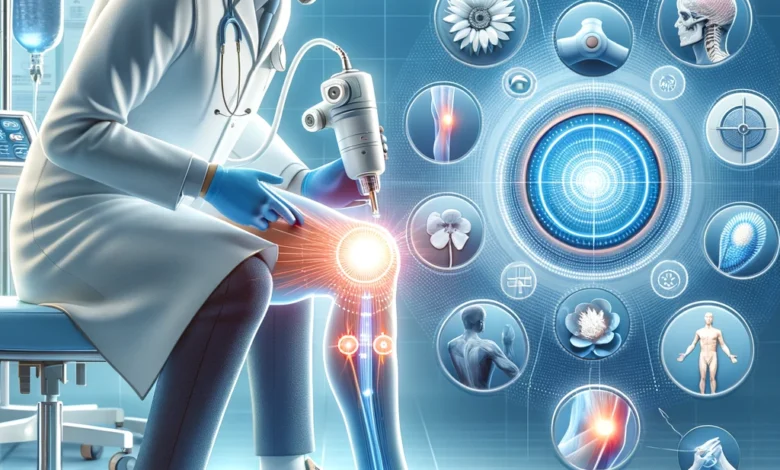Shock Wave Therapy: A Comprehensive Guide to Applications and Benefits in Modern Medicine

Shock wave therapy, a non-invasive treatment method that employs acoustic waves to treat various medical conditions, has gained considerable traction in modern medicine. From its initial use in breaking down kidney stones, its applications have expanded into orthopedics, cardiology, urology, and even aesthetic medicine. This comprehensive guide explores the science behind shock wave therapy, its diverse applications, benefits, and the future potential of this versatile treatment modality.
Understanding Shock Wave Therapy
Shock wave therapy, also known as extracorporeal shock wave therapy (ESWT), utilizes high-energy sound waves to stimulate healing processes in the body. These shock waves are acoustic pulses that carry energy to injured tissues, promoting regeneration and repair. The technology is categorized into two main types:
- Focused Shock Wave Therapy (FSWT): Delivers concentrated waves to a specific point, used primarily for targeting deep tissues.
- Radial Shock Wave Therapy (RSWT): Disperses waves over a broader area, suitable for treating superficial tissues.
Both types of shock wave therapy are used based on the condition being treated and the location of the affected tissues.
Mechanism of Action
Shock wave therapy works through several mechanisms:
- Mechanical Stimulation: The acoustic waves create microtraumas in the tissues, triggering the body’s natural healing response.
- Increased Blood Flow: Shock waves stimulate the formation of new blood vessels, enhancing blood supply and oxygenation to the affected area.
- Cellular Effects: The therapy induces the release of growth factors and other healing molecules, aiding in tissue regeneration.
- Pain Reduction: It modulates pain perception by affecting nerve endings and reducing inflammation.
Applications in Modern Medicine
Shock wave therapy’s versatility allows it to be used in various medical fields, each benefiting from its unique properties.
Orthopedics
One of the most common applications of shock wave therapy is in orthopedics, where it treats conditions like:
- Plantar Fasciitis: Shock wave therapy is highly effective in reducing pain and promoting healing in patients with plantar fasciitis, a common cause of heel pain.
- Tendinopathies: Conditions such as Achilles tendinitis, patellar tendinitis, and tennis elbow respond well to shock wave therapy, which stimulates tendon repair.
- Bone Healing: Shock waves promote the healing of fractures and non-unions by stimulating bone growth and enhancing callus formation.
- Calcific Shoulder Tendinitis: This condition, characterized by calcium deposits in the shoulder tendons, sees significant improvement with shock wave therapy, which helps break down the deposits and relieve pain.
Urology
Shock wave therapy revolutionized urology with its ability to non-invasively treat kidney stones through a process called lithotripsy. The acoustic waves break the stones into smaller fragments, allowing them to pass through the urinary tract more easily. To shock wave therapy get visit here : https://www.ultimatemedgroup.com/prolotherapy
Cardiology
In cardiology, shock wave therapy is emerging as a potential treatment for:
- Chronic Refractory Angina: Shock waves can induce angiogenesis, the formation of new blood vessels, improving blood flow to the heart in patients with chronic angina.
- Myocardial Regeneration: Research is ongoing to explore the potential of shock waves in regenerating heart tissue post-myocardial infarction.
Dermatology and Aesthetic Medicine
Shock wave therapy has found its way into dermatology and aesthetic medicine for its skin rejuvenation and body contouring benefits:
- Cellulite Reduction: Shock waves help break down fat deposits and stimulate collagen production, reducing the appearance of cellulite.
- Skin Tightening: The therapy promotes collagen and elastin production, leading to firmer and more youthful-looking skin.
- Scar Treatment: Shock wave therapy can improve the appearance of scars by enhancing blood flow and collagen remodeling.
Benefits of Shock Wave Therapy
The widespread adoption of shock wave therapy can be attributed to its numerous benefits:
- Non-Invasive: Unlike surgical interventions, shock wave therapy does not require incisions, reducing the risk of complications and recovery time.
- Minimal Side Effects: The therapy is generally well-tolerated, with few side effects such as mild discomfort or redness at the treatment site.
- Effective Pain Relief: Many patients experience significant pain relief after just a few sessions.
- Accelerated Healing: Shock wave therapy enhances the body’s natural healing processes, leading to faster recovery times.
- Versatile Applications: Its use in various medical fields highlights its adaptability and effectiveness in treating diverse conditions.
Procedure and Treatment Protocol
A typical shock wave therapy session involves the following steps:
- Assessment: The healthcare provider evaluates the patient’s condition and identifies the treatment area.
- Preparation: A gel is applied to the skin to facilitate the transmission of shock waves.
- Application: The shock wave device is positioned over the treatment area, and the therapy is administered. Sessions usually last 15-30 minutes.
- Follow-Up: Multiple sessions may be required, depending on the condition being treated and the patient’s response to therapy.
Potential Risks and Contraindications
While shock wave therapy is generally safe, certain risks and contraindications must be considered:
- Contraindications: Patients with blood clotting disorders, infections, or tumors in the treatment area should avoid shock wave therapy. It is also not recommended for pregnant women.
- Risks: Some patients may experience temporary discomfort, swelling, or bruising. Rarely, more severe complications like tendon or nerve damage can occur.
Future Directions and Research
The future of shock wave therapy looks promising, with ongoing research exploring new applications and refining existing protocols. Areas of interest include:
- Regenerative Medicine: Investigating shock waves’ potential to promote stem cell activity and tissue regeneration.
- Neurological Applications: Exploring the use of shock wave therapy in treating conditions like neuropathic pain and neurodegenerative diseases.
- Enhanced Delivery Systems: Developing more sophisticated devices and techniques to optimize the delivery and effectiveness of shock wave therapy.
Case Studies and Clinical Evidence
Numerous studies support the efficacy of shock wave therapy across various medical fields. Some notable examples include:
- Orthopedics: A study published in the “Journal of Bone and Joint Surgery” reported a significant reduction in pain and improved function in patients with chronic plantar fasciitis treated with shock wave therapy.
- Cardiology: Research in the “Journal of the American College of Cardiology” demonstrated improved exercise tolerance and reduced angina symptoms in patients with refractory angina after shock wave therapy.
- Dermatology: Clinical trials have shown that shock wave therapy effectively reduces the appearance of cellulite and improves skin elasticity.
Patient Experiences and Testimonials
Patient testimonials highlight the positive impact of shock wave therapy on their lives:
- John, a 45-year-old athlete: “After struggling with Achilles tendinitis for years, shock wave therapy was a game-changer. The pain is gone, and I’m back to running.”
- Maria, a 38-year-old professional: “I tried everything for my chronic heel pain, but nothing worked until I discovered shock wave therapy. It’s been a lifesaver.”
- Helen, a 50-year-old homemaker: “The cellulite on my thighs bothered me for years. Shock wave therapy made a noticeable difference, and I feel more confident.”
Conclusion
Shock wave therapy represents a significant advancement in modern medicine, offering a non-invasive, effective, and versatile treatment option for a wide range of conditions. Its ability to stimulate the body’s natural healing processes, reduce pain, and improve functionality makes it an invaluable tool in various medical fields. As research continues to uncover new applications and refine existing protocols, the future of shock wave therapy looks increasingly promising, paving the way for even broader use and greater patient benefits.


